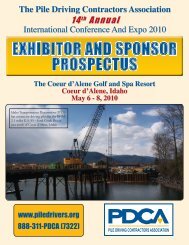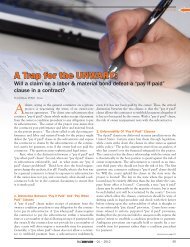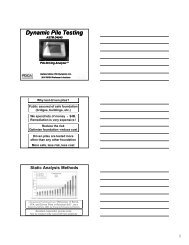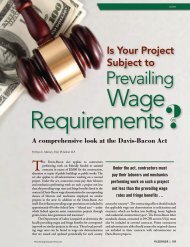Full Issue (17 MB) - Pile Driving Contractors Association
Full Issue (17 MB) - Pile Driving Contractors Association
Full Issue (17 MB) - Pile Driving Contractors Association
Create successful ePaper yourself
Turn your PDF publications into a flip-book with our unique Google optimized e-Paper software.
OSHA has tasked each of its inspectors with the duty to determine<br />
whether the training provided by an employer satisfies the intent of<br />
the Standard—whether employees receiving the training have actually<br />
understood the content. Obviously, this is a highly subjective exercise.<br />
One way that an OSHA inspector will make this evaluation is to interview<br />
employees. These interviews may or may not take place in the presence<br />
of a management representative. Many OSHA inspectors are bilingual,<br />
speaking both in English and Spanish, and those who are not may<br />
request another employee to act as an interpreter to translate during<br />
an employee interview. Translation issues can present potential bias<br />
problems during employee interviews, whether the interpreter is<br />
another employee, a management representative or an OSHA official.<br />
For this reason, employers must ensure that employees understand<br />
their right to have a management representative present during the<br />
interview. Employers may also consider requesting that a neutral thirdparty<br />
act as interpreter during the employee interview, particularly if<br />
the interview is critical and accuracy is an important consideration.<br />
Another way OSHA inspectors will evaluate the employer’s<br />
compliance with safety training standards is by determining how<br />
the employer communicates other workplace rules and policies to<br />
employees, particularly job instructions and other non-safety policies<br />
or procedures. If these other job instructions are given in Spanish,<br />
for example, OSHA will likely view English-only safety training as<br />
insufficient. Ultimately the OSHA inspector will determine, based on a<br />
review of all of the gathered facts, whether a reasonable person would<br />
conclude that the employer has not conveyed training to employees<br />
in a manner they are capable of understanding. In one case involving<br />
deficient safety training, a supervisor described the company’s training<br />
program as follows: “Basically, in the yard with the men making sure<br />
they got their vests, their shoring, their boards before they leave for the<br />
job. They are directed to not get in holes over four feet deep, when it’s<br />
unsafe to use the proper shoring.” Sec. of Labor v. J. Mess Plumbing Co.,<br />
Inc., 21 O.S.H. Cas. (BNA) 1100 (A.L.J. Oct. 18, 2004). In this case, most of<br />
the company’s employees had immigrated from Bosnia and Albania and<br />
could not speak English. Where an employee could not speak English,<br />
another co-worker would translate the materials for him. In addition,<br />
the employer did not maintain any documentary evidence of a training<br />
program. An administrative law judge upheld OSHA’s citation under a<br />
construction industry training standard, finding that the employer hired<br />
workers that were not fluent in English, and then failed to ensure that<br />
they understood the minimal training they received.<br />
Recent case law precedent from the Occupational Safety and Health<br />
Review Commission validated OSHA’s ability to issue citations under its<br />
training standards on a per-employee basis. This means that OSHA can<br />
issue a separate citation and penalty for each and every employee who<br />
did not understand his or her required safety training. In Sec. of Labor<br />
v. E. Smalis Painting Co., slip op., O.S.H.R.C. Docket No. 94-1979 (Apr.<br />
10, 2009), OSHA issued a total of 71 willful citations to Smalis for failure<br />
to train 71 employees as required in OSHA’s “Lead in Construction”<br />
Standard, 29 C.F.R. § 1926.62(l)(1)(ii). The review commission upheld 27<br />
of those willful citations, one for each of the 27 employees who had<br />
been exposed to lead at or above the action level and who had not<br />
received the training, and imposed a penalty of over $1,000,000 in total.<br />
The review commission’s decision was based on its finding that<br />
training requirements under OSHA’s asbestos standard impose a duty<br />
that runs to each employee. While the Smalis decision is based on<br />
the employer’s failure to train altogether, the review commission’s<br />
reasoning may well be applied to situations involving the adequacy of<br />
an employer’s training program as it relates to non-English-speaking<br />
employees.<br />
ENGLISH-ONLY EMPLOYMENT POLICIES FOR<br />
SAFETY-SENSITIVE AREAS<br />
Employers may be tempted to avoid OSHA’s onerous and subjective<br />
training policies by employing only English-speaking workers. Employers<br />
must proceed with extreme caution in fashioning these types of policies<br />
so as not to run afoul of federal and state anti-discrimination laws.<br />
Employers who fashion English-only policies, prohibiting employees from<br />
speaking languages other than English at all times in the workplace, are<br />
presumed to be discriminating on the basis of an employee’s national<br />
origin. The federal regulations implementing Title VII of the Civil<br />
Rights Act call such policies “a burdensome term and condition of an<br />
employment,” and provide that prohibiting non-English languages in<br />
the workplace at all times “disadvantages an individual’s employment<br />
opportunities on the basis of national origin” and creates “an<br />
atmosphere of inferiority, isolation and intimidation based on national<br />
origin.” 29 C.F.R. § 1606.7(a).<br />
These same regulations do recognize, however, that when applied<br />
only at certain times an English-only policy in the workplace may be<br />
appropriate and non-discriminatory. To avoid liability for discrimination,<br />
the employer must establish that the rule is justified by a “business<br />
necessity.” 29 C.F.R. § 1606.7(b). In its compliance manual, the Equal<br />
Employment Opportunity Commission (EEOC) has recognized that the<br />
need for the safe operation of an employer’s business is considered a<br />
business necessity, that can justify an English-only rule that is tailored<br />
to specific circumstances. The EEOC also recognizes that the need for<br />
supervisors who only speak English to communicate with employees<br />
is also a business necessity, that can justify an appropriately narrow<br />
English-only policy.<br />
The EEOC cites the following scenario as an appropriate use of an<br />
English-only rule to address safety concerns:<br />
XYZ Petroleum Corp. operates an oil refinery and has a rule requiring<br />
all employees to speak only English during an emergency. The rule also<br />
requires that employees speak in English while performing job duties<br />
in laboratories and processing areas where there is the danger of fire<br />
or explosion. The rule does not apply to casual conversations between<br />
employees in the laboratory or processing areas when they are not<br />
performing a job duty. The English-only rule does not violate Title VII<br />
because it is narrowly tailored to safety requirements. EEOC Compliance<br />
Manual, Section 13: National Origin Discrimination (Dec. 2, 2002).<br />
According to this example, an employer would not run afoul of<br />
federal non-discrimination laws by requiring employees to speak only<br />
REPRINTED FROM CONCRETE OPENINGS | VOL.18 | NUM.3 | SEPTE<strong>MB</strong>ER 2009

















